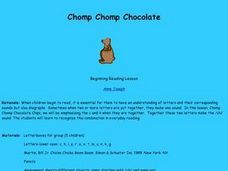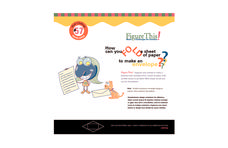Curated OER
Muggie Maggie - Lesson 5
Pupils complete activities with the book Muggie Maggie by Beverly Cleary. In this literature lesson, students discuss new vocabulary words and definitions for Ch. 5. They read Ch. 5 and find synonyms and antonyms for their vocabulary...
Curated OER
Introducing Chemistry Vocabulary
Students study vocabulary based on chemistry terms by creating flash cards. In this scientific vocabulary lesson, students utilize a chemistry word or phrase to create a card which uses the term, describes it in the student's...
Curated OER
Shhhhhhh! The sheep are sleeping!
Students examine the use of /sh/ in written and spoken words by watching how their mouth moves while making the sound, identifying words, listening to a story, and making words with Elkonin letterboxes. As an assessment, they complete a...
Curated OER
Go, Speed Reader, Go
Young scholars increase their reading fluency through the use of various strategies. After reviewing chunking, decoding, and rereading, students complete an initial read of a novel text. Working in small groups, they read complete a...
Curated OER
Chicka, Chicka, Choo, Choo
Students begin to read and spell words vis phonemes and letter correspondences. They encounter the concept digraph. This lesson helps the students see a c and h together, they make the ch sound. So, that the students recognize this...
Curated OER
Chocolate Chip Cookies for Lunch
First graders identify the digraph /ch/ in written and spoken language. After a brief discussion of the independent and combined sounds of the phonemes /c/ and /h/ students practice identifying initial and final placement of the new...
Curated OER
Chimps Chugging Chocolate Milk
First graders identify the digraph /ch/ in written and spoken language. After a brief discussion of the independent and combined sounds of the phonemes /c/ and /h/ students practice identifying initial and final placement of the new...
Curated OER
The Little Engine that Chattered Choo Choo
First graders identify digraphs in written and spoken language. After a brief discussion of the combinations of /c/ and /h/ that comprise the /ch/ digraph, 1st graders practice identifying initial and final placement of the digraph /ch/...
Curated OER
Making Questions
In this questions worksheet, students write questions that go with given answers, 10 answers total. Students are directed to use "where, when what time or why" questions.
Curated OER
Quiz: Noun + Is/Are
In this noun instructional activity, students make either singular or plural sentences with given words and either is/are where appropriate.
Curated OER
Chomp Chomp Chocolate
Students identify the digraph /ch/ in written and spoken language. Students practice identifying the initial and final placement of the digraph /ch/ in words by identifying pictures containing the sound. They read a decodable story...
Curated OER
Chocolate Chicken
Students identify digraphs in written and spoken language. After a brief discussion on the combinations of letters that comprise digraphs, students practice identifying initial and final placement of the digraph /ch/ in words and tongue...
Curated OER
Chug-a-Chug-a Choo Choo
First graders identify the digraphs in written and spoken language. After a brief discussion on the combinations of letters that comprise digraphs, 1st graders practice identifying initial and final placement of the digraph /ch/ in words...
Curated OER
Hunter Model 2
Students produce the long sounds in the initial position of words making silly soup.
Curated OER
Sound Stretching
In this basic vowel and consonant blending lesson, young learners are shown how to "blend" the sounds of different letters together in order to make a word. Simple words such as, "sun," "moon," and, "ant," are used in a whole-class setting.
Curated OER
I Think I Can
Students identify the digraph /ch/ in written and spoken language. Students practice the production of the /ch/ sound through tongue twister. They identify the initial and final placement of the digraph /ch/ by reading a story to a partner.
Curated OER
Champions Check
First graders identify consonant digraphs in written and spoken language. After a brief discussion of the combinations of /c/ and /h/ that comprise the /ch/ digraph, 1st graders practice identifying initial and final placement of the...
Curated OER
Go Speed Racer!
Pupils increase their reading fluency through one-minute drills. Working in pairs, students read a grade level appropriate text in one-minute intervals. After reading they determine their speed through a word count. Pupils complete...
Curated OER
Haunting of Third Grade
Third graders discuss the meaning of the word "haunted." They watch as the teacher demonstrates using a sticky note to mark words that they find interesting in their reading. Students read chorally, then break into groups for a...
Curated OER
Math Challenges
Students participate in a series of challenging math lessons designed to engage their critical thinking skills. In these real-world problem solving lessons, student solve symmetry and repeated pattern problems, make lists/tables to...
Curated OER
Introduction to "The Secret School"
Fourth graders read The Secret School and define vocabulary in the text. In this Secret School lesson, 4th graders recognize difficult text and are able to comprehend its meaning and answer questions.
Curated OER
The Reformers: Martin Luther and César Chávez
Kids consider the characteristics needed to be reformers like Martin Luther King and Cesar Chavez. They read a series of quotes focused on both animal and human rights to answer eight critical thinking questions.
Curated OER
The Yangtze River: Lifeline of China
Learners locate the Yangtze river on a map, and label major cities and landmarks. Students identify and interpret the diversity of the people living along the Yangtze. Learners explain the pros and cons of the
Three Gorges Dam project.
Curated OER
Expressions of Quantity
In this expressions of quantity worksheet, learners choose an expression of quantity to describe a group of numbers or symbols. Students use the phrases "all of", "almost all of", "most of", "some of", or "non of" to describe the sets.























